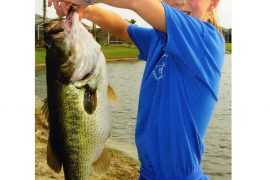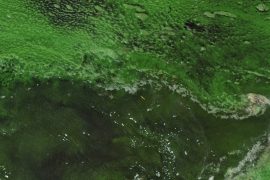By Mike Holliday
Use these tips to catch more fish.

April can be a windy month on Florida’s east coast, but when Mike Readling and I cleared the St. Lucie Inlet the ocean couldn’t have been flatter if it was frozen. It was a wideopen run to 100 feet of water where deployed our live baits and started the slow-troll crawl to deeper water.
At 140 feet we pushed up to an underwhelming color change, no grass, current or upwelling, so I wasn’t expecting much, until a wall of juvenile flyingfish went airborne. When I saw the skipping fliers I pointed the boat north, directly up the color change, and every few minutes we kicked up another school.
That volume of food is impressive on any day, and I knew that a large concentration of flyingfish would surely draw gamefish. We cruised the color change for almost a mile without a single knockdown, and I was starting to think about a move, when a school of flyingfish several hundred yards ahead of the boat got up.
We were obviously too far from the school to push it, so I bumped up the throttle and headed for the last splash of bait, but before we got there we could see four feet of green shadow cruising the edge of the color line.
1. Have A Pitch Bait Ready

“Grab the spinning rod,” I shouted to Readling. “The fish is going left to right after that school. I’m going to come up on the right of it. Cast the second you think you can reach it.”
There really wasn’t any reason to bark directions. Once we were up-tide of the fish and had it to one side of the boat you could have blind cast the bait over your shoulder and the fish would have rushed up and pounded it, it was so lit up. We also caught a cow dolphin that we never saw and was traveling down deep.
I can close my eyes and see that fish eat today, and I know deep in my heart that the reason we spanked those two 30-pound dolphin was because we were prepared for whatever scenario we encountered. That bull was traveling at a good clip and we may or may not have been able to speed up and get our live baits in front of it without spooking the fish, but with a pitch bait ready, we were locked, cocked and ready to rock when a moving dolphin came along.
And you should be too. It should be standard practice when offshore fishing to hook a bait on a spinning rod and put it in a livewell or 5-gallon bucket filled with seawater in the corner of the cockpit ready to throw to any fish that comes within casting distance. Some boats even come standard with “pitch wells” for just such an occasion.
And don’t feel like you have to have a live bait ready. A rigged ballyhoo, mullet or flying fish will give you almost the same odds with these opportunity feeders.
2. Tease Them In

The same goes for teasers. It should be SOP to deploy at least one, and optimally two teaser chains in your bait spread.
In case you haven’t noticed, a fish’s eyes are on the top of its head, so in cruising position it’s constantly looking forward or up. Six or eight small baits cruising in a boat wake are tough enough to distinguish, but a flashing string of baits or splashing chain of squids stick out like a hammered thumb.
Squid chains, live or dead bait teasers all work most efficiently when deployed in the boat wake, particularly tight to the boat using a clip system off the stern. The splashing and flashing of teasers draw attention to the baits in the spread and help the dolphin lock in on their target. I’ve seen dolphin swim up and eat three or four dead teaser baits ten feet from the transom before finally getting to a live bait with a hook in it, but eventually they find the right one.
3. Find The Bait
Keep in mind that a fish may weigh 40 pounds or more but it still has a brain the size of a pea and is driven by three basic concepts: food, comfort and reproduction, in that order. That being said, when you find the food, you usually find the fish, so just about any time you’re marking bait or seeing it in the area, you’re in a plus zone.
After all, it’s a giant ocean out there, and fish have to eat to survive, so they’re constantly on the move looking for an easy meal. Any time dolphin find an abundance of food, they’re more likely to stick around and “chow down” than eat and run. So whenever you find good concentrations of bait, you want to stick in that area and then try to add more positive factors to your fishing.
Whether the baits are flying fish, ballyhoo, threadfins, sardines or another bait food species, look for nearby structure that the fish might hold around when not feeding like floating sargassum, reefs or wrecks. Watch for baitfish scattering and run right to that location when it happens, and also watch for turtles or other large marine species.
4. Fish Every Turtle

Turtles typically hang out around the reefs and they’re constantly moving up and down in the water column. Dolphin will hang out around turtles, particularly those on the surface that are resting after being underwater for some time. I don’t know if it’s the shade, safety of structure or proximity to the reef that dolphin like, but a lot of big dolphin are caught off of turtles, particularly during the summer doldrums.
For that reason, you want to cast to or troll by every turtle you see, even if it means changing course and leaving a good rip, edge or weedline….





